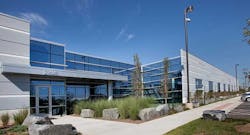Digital Realty and DuPont Fabros Technology (DFT) have gone head-to-head in the data center business for years. They have similar business models, and target many of the same geographic markets and customers. There’s long been speculation that the two companies might get together.
Thus, Friday’s announcement that Digital Realty would acquire DFT in an all-stock $7.6 billion merger makes sense.
But why now? And what now? Those were the questions being asked by securities analysts and industry watchers in the wake of Friday’s announcement.
The merger creates a cloud colossus with 26 million square feet of data center space, and provides the new Digital Realty with clear leadership in the two hottest markets: Northern Virginia and Chicago.
It also shifts the competitive balance in the rapidly-changing data center industry, particularly in the market for wholesale (“plug and play”) data center space.
The timing is driven by several trends:
- The cloud has become a game-changer for the data center industry. DFT and CyrusOne were winning the lion’s share of super-sized cloud leases, prompting Digital Realty to make a big move to regain its mojo in this important niche.
- To compete for the huge cloud deals, you’ve got to have inventory. DFT’s construction program has been expertly managed to create a ready pipeline of large-footprint data center space in the most important markets, along with land in several key growth markets.
- The deal reflects the growing importance of “availability zones” in cloud real estate. Availability zones, which spread capacity across multiple data centers within a single geographic market, are a strategy developed by cloud leader Amazon Web Services. Now AWS rivals Microsoft, Google and Oracle are rushing to create similar diversity in major markets. The DFT deal provides Digital Realty with additional diversity in key geographies.
- While going on offense, Digital Realty is also playing strong defense. If DuPont Fabros is ready to be acquired, Digital Realty wants to be the one to do it, rather than seeing DFT scooped up by a rival, particularly one with hyperscale ambitions like CyrusOne.
Megadeals Emerge As Battleground
As cloud computing has boosted the fortunes of data center developers, the ability to land the huge “super wholesale” hyperscale deals has become a differentiator. As DFT and CyrusOne continued to land the megadeals, industry observers were left to wonder whether Digital Realty could succeed in this niche.
The acquisition of DuPont Fabros answers those questions, creating an enviable base of hyperscale customers and capacity:
The deal boosts Digital Realty’s position in the hyperscale data center market. (Graphic: Digital Realty)
DuPont Fabros has a solid pipeline for future growth, with six data center development projects that can deliver capacity within the next 12 months. DFT also owns land for expansion in Ashburn and Oregon, which will support the future delivery of up to 163 megawatts of incremental capacity, along with 56 acres of land recently acquired in Phoenix.
Shift in Acquisition Criteria
Digital Realty has been a serial acquirer of data center properties and portfolios, as seen in its purchases of Sentinel Data Centers in 2009 and 365 Main in 2010. In 2015, Digital Realty bought an eight-building portfolio in Europe from Equinix.
But the biggest deal to date had been the $1.9 billion acquisition of Telx in 2015, which accelerated Digital Realty’s push into the market for colocation and interconnection services. The addition of Telx brought critical mass to its “connected campus” strategy that brings together real estate and network services. But the Telx integration also required management focus at a time when the cloud market was rapidly transitioning to larger deals.
“Pursuing cloud projects has always been part of our strategy,” said Scott Peterson, the Chief Investment Officer of Digital Realty. “Admittedly, we’ve focused most of our M&A attention on colocation and interconnection. We believe these (DFT) assets will see significant benefits from our connectivity strategy.”
Zoning Out
In a conference call Friday morning, CEO Bill Stein said the merger offers particular benefits in markets like Ashburn and Suburban Chicago, where both companies operate multiple data centers and have projects in development.
Stein said Digital Realty is now better positioned to address cloud providers’ focus on building availability zones – clusters of data centers within a region that allow customers to run instances in several isolated locations to avoid a single point of failure.
“The ability to offer more than one campus environment within a single metro area will enable the combined company to compete for multiple availability zones within the same metropolitan area, particularly from cloud service providers who may have certain distance requirements between deployments in a given metro area,” said Stein. “The combined organization really will be the home to the cloud.”
To illustrate the point, Digital Realty outlined the cluster of data centers the company will operate in the three largest U.S. data center markets.
The focus on availability zones is prompting some providers to acquire more properties. Earlier this year QTS Data Centers bought a second large campus in the Dallas market, even though it has capacity remaining on its first Dallas campus. QTS says customer interest in multiple availability zones was a factor in that decision.
Playing Defense
This isn’t the first time DuPont Fabros has considered selling. The company reviewed its options after Chris Eldredge was named CEO in early 2015, succeeding founder and long-time CEO Hossein Fateh. At a time when Digital and other wholesale providers were adding colocation and interconnection services, Eldredge and his team opted to double down on wholesale.
DuPont Fabros updated its design to deploy new space in smaller increments, and allow for variable resiliency in its data centers. This eliminated a dynamic in which vacant space would put pressure on the leasing team (as well as pricing). Eldredge also opted to divest the NJ1 data center in New Jersey, where DuPont Fabros struggled to fill space, and enter new markets in Toronto, Portland and Phoenix.
The new strategy paid off in a burst of leasing, and a reduction in vacant space and debt – all of which made DFT more interesting to Digital Realty, which has emphasized its need to remain disciplined in its acquisitions.
“This is something we’ve had conversations on for years,” said Peterson. “In the past, the economics weren’t as attractive as they are today. This is a different company than it was three years ago.”
The Road Ahead
There are some differences that will need to be sorted out going forward as the two companies integrate. Stein said there has been no decision on whether Digital Realty would continue to use its own design for new construction, or adapt elements of the DuPont Fabros design.
A Caterpillar diesel backup generator at the DuPont Fabros ACC7 data center in Ashburn. (Photo: Rich Miller)
There are several other differences. Digital Realty uses a full service lease that includes expenses, while DuPont Fabros leases space on a triple-net basis, in which customers are responsible for the costs of ongoing expenses, including real estate taxes, building insurance and maintenance.
The companies also approach design and equipment differently, particularly in the power chain, where DFT uses rotary (flywheel) UPS systems, while Digital Realty uses traditional battery-backed UPS systems.
Then there’s the issue of finding space to grow in Santa Clara, the primary data center market in Silicon Valley. Development sites are scarce in Santa Clara, and neither Digital Realty or DuPont Fabros have announced expansion plans there in the supply-constrained market. The good news is that most competitors are facing the same dilemma, with the exception of Digital Bridge, which recently acquired Vantage Data Centers and its shovel-ready expansion campus. CyrusOne has no presence in Santa Clara, but has announced plans to enter the market.
Will Digital Realty’s big move prompt more deals, nudging rivals to scoop up some of the many companies and assets currently reported to be for sale? Share your opinion in the comments.






